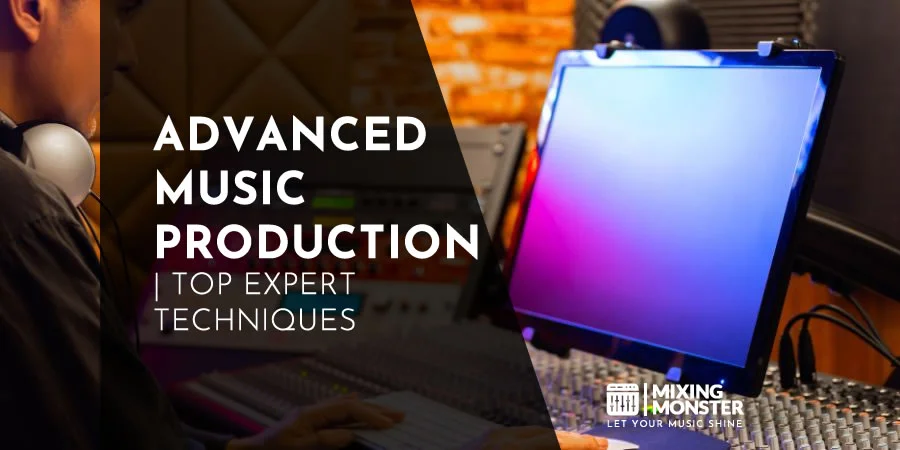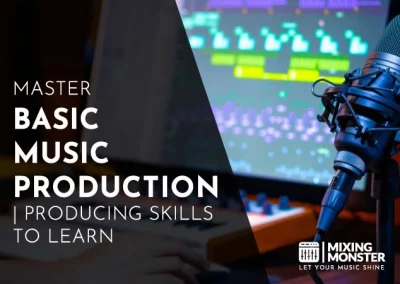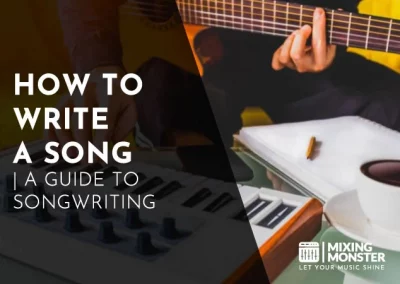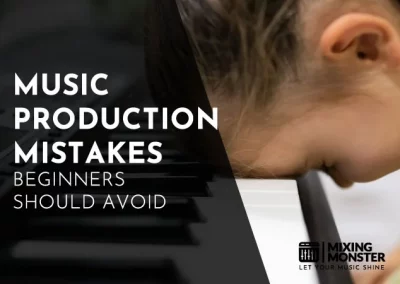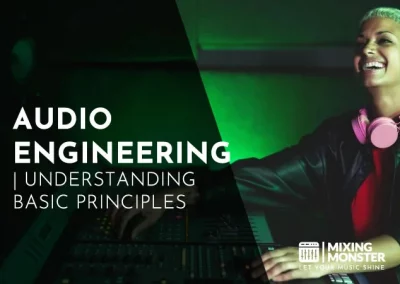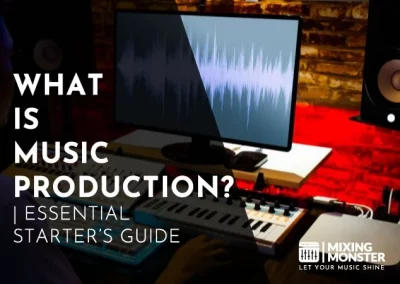Home > Blog > Music > Music Production
Disclosure: Some of the links below are affiliate links, meaning that at no additional cost to you, we will receive a commission if you click through and make a purchase. Read our full affiliate disclosure here.
Breaking into advanced music production is an exhilarating step for any artist or producer. It’s the realm where creativity fuses with cutting-edge technology, allowing for the construction of unique soundscapes and crystal-clear audio quality that captivates listeners.
Advanced music production is the skillful application of technical knowledge and artistic creativity to create, arrange, record, and manipulate sound. It encompasses a broad spectrum of competencies, from intricate sound design to sophisticated mixing and mastering techniques. This domain involves using Digital Audio Workstations (DAWs), various plugins and outboard gear, and an in-depth understanding of audio theory. As a producer, developing these skills is critical in delivering professional-sounding tracks that stand out in the competitive music industry.
As you dive further into this article, you’ll gain insights into the multiple facets of advanced music production. Whether creating immersive audio experiences, orchestrating complex MIDI arrangements, or leveraging high-end studio hardware, the knowledge you’ll accumulate here will elevate your productions. Expect to uncover expert tips and best practices to guide you through refining your sound and achieving excellence in your music production journey.
KEY TAKEAWAYS:
- Advanced production techniques refine sound quality and creativity in music.
- Mastery of DAWs, sound design, and audio engineering is central to professional production.
- Implementing expert strategies in mixing and mastering is crucial for top-tier audio outputs.
Table Of Contents
1. Digital Audio Workstations (DAWs) In Advanced Music Production
2. Advanced Sound Design Techniques
3. Expert Audio Mixing Strategies
4. Audio Mastering In The Modern Age
5. Immersive And Spatial Audio Production
6. Advanced MIDI Orchestration And Arrangement
7. High-End Hardware In The Studio
8. Innovative Music Production Techniques And Technologies
9. Professional Music Production Tips And Best Practices
10. Wrapping It Up: Your Path To Advanced Music Production
11. FAQ

1. Digital Audio Workstations (DAWs) In Advanced Music Production
Digital Audio Workstations are the cornerstone of modern music production, providing a comprehensive environment for recording, editing, mixing, and mastering. The right DAW can revolutionize your creative process, allowing you to produce professional-quality music with precision and efficiency.
Exploring The Latest DAW Features And Updates
The landscape of DAWs is constantly evolving, with updates that enhance functionality and workflow.
Ableton Live remains a leader for its intuitive live performance capabilities, recently bolstering its already robust platform with enriched MIDI editing and performance features.
Meanwhile, Pro Tools has solidified its status in professional recording studios with advanced editing tools and Avid’s consistent dedication to stability.
Users of Logic Pro can now enjoy an expanded array of loops and samples, complemented by improved comping and sequencing functionalities.
Reason brings a unique rack of virtual instruments and effects for those inclined towards electronic and beat-driven genres, emulating a real-world modular synth setup.
| DAW | Unique Feature | Latest Update |
|---|---|---|
| Ableton Live | Session View | Enhanced MIDI editing, integration with Push |
| Pro Tools | Advanced Editing Tools | Increased efficiency, track presets |
| Logic Pro | Seamless Apple Integration | Improved Sampler, Quick Sampler, and Auto Sampler |
| Reason | Rack Extensions | Expanded mixer, improved sequencer |
Integrating DAWs With Advanced Music Production Workflows
Your choice of a DAW should seamlessly integrate into your production workflow.
Pro Tools offers unparalleled precision for complex sessions requiring intricate sound manipulation. Its robust audio engine and extensive plugin compatibility make it suitable for nuanced editing tasks.
Logic Pro, with its musician-friendly interface, fits well for composers and arrangers looking to leverage the power of its sophisticated MIDI and scoring capabilities.
Meanwhile, Ableton Live is favored for its loop-based concoctions and real-time manipulation, serving those who enjoy on-the-fly creation and improvisation.
For sound designers and electronic music producers, Reason offers a tactile expression of sound synthesis and a unique sequencer that can spur creativity.
- Pro Tools:
Precision editing and broad plugin support. - Logic Pro:
Comprehensive MIDI and scoring tools. - Ableton Live:
Fluid loop-based composition, live performance. - Reason:
Creative sound design, unique sequencing approach.
Customizing Your DAW For Enhanced Productivity
Customizing your digital audio workstation is essential to refine your production process. Every DAW, including Ableton Live, Pro Tools, and Logic, offers personalized key commands and template creation. These tools aid you in crafting a tailored environment that caters to your workflow, enabling you to perform repetitive tasks faster. Ableton Live stands out with its Push hardware integration, providing hands-on control and maximizing productivity. Use the customizable mixer views in Pro Tools or the Smart Controls in Logic Pro to speed up your mixing process.
Personalization Tips:
-
- Configure key commands for frequently used actions.
- Create templates for different types of projects.
- Utilize dedicated hardware for tactile control with Ableton Live.
- Make use of customizable views and controls in Pro Tools and Logic Pro.
2. Advanced Sound Design Techniques
Expanding your production abilities, advanced sound design techniques allow you to create uniquely textured audio. Your understanding of synthesis and sampling is pivotal to sculpting sophisticated soundscapes.
Overview Of Advanced Sound Design
Sound design is more than just an element of music production; it’s an art form that transforms and elevates your musical expression. You can manipulate waveforms to achieve complex sounds through various synthesis methods, including additive, subtractive, FM (Frequency Modulation), and wavetable.
On the other hand, sampling involves capturing audio snippets to be repurposed creatively. This consists of pitching, stretching, or mangling the sample, essential in genres like hip-hop and electronic music, to add texture and depth to your tracks.
Synthesizer And Sampling In-Depth
Synthesizers are instrumental in electronic sound production, offering an expansive palette for sonic creation. Learn to utilize oscillators, filters, LFOs (Low-Frequency Oscillators), and ADSR envelopes (Attack, Decay, Sustain, Release) to mold your timbre from the ground up.
An in-depth understanding of these parameters can dramatically alter your sound’s character. In terms of sampling, harnessing tools for chopping, looping, layering, and applying various effects can breathe new life into established sounds, transforming them into something entirely your own.
Utilizing Modular Environments For Unique Soundscapes
Venture into the world of modular environments to explore uncharted acoustic territories. Unlike traditional synthesizers, modular setups allow you to patch components in numerous configurations, crafting unique soundscapes that are impossible to replicate entirely.
You unlock many sonic possibilities by connecting oscillators, filters, modulators, and sequencers in novel ways. The flexibility of this approach encourages experimentation, making it a playground for avant-garde sound design.
3. Expert Audio Mixing Strategies
In this section, you’ll explore advanced techniques designed to enhance your music mix’s clarity, depth, and dynamism.
Achieving Clarity And Depth In Your Mixes
Give each instrument space in the frequency spectrum to achieve clarity in your mixes. This can be done by employing high-pass and low-pass filters to remove unnecessary frequencies. A technique to improve depth is to manipulate reverb. A short reverb will bring your sound to the front, while a longer reverb can push it back, creating a sense of space.
- High-Pass Filter:
Cut the lows to clear up mud - Low-Pass Filter:
Cut the highs to soften and situate sounds in the background
Advanced EQ And Compression Techniques
Expert EQ maneuvers involve more than just boosting and cutting; it’s about understanding the harmonic content of your sounds and how they interact. Use subtractive EQ to carve out space for elements with similar frequency ranges.
Compression is vital for controlling the dynamics of your mix. It’s not just about making loud sounds quieter; it’s also for adding punch or sustain to a sound.
Dynamic EQ:
A merging of EQ and compression, reacting to the input signal to combine tonal balance with dynamic control.
Utilizing Sidechain And Dynamic Processing
Sidechain compression is renowned for its role in electronic music, creating that pumping effect by tying the compressor on one track to the output of another. You can use this in your mix to ensure your kick cuts through a bass-heavy mix by automatically reducing the bass volume whenever the kick hits.
- Sidechain Source:
Kick Drum - Sidechain Target:
Bass Synth - Effect:
Bass volume ducks with each kick, allowing the kick to stand out.
Dynamic processing isn’t only about controlling peaks; it’s an artistic choice that can define the groove and feel of a track. It includes techniques like expansion and multi-band compression, which allow you to target specific frequency ranges and dynamic behaviors.
Remember to use pan to place elements in the stereo field, creating a wider and more immersive listening experience without overcrowding any one area of the mix.
4. Audio Mastering In The Modern Age
Audio mastering is a critical final step in the production process that ensures your music meets professional standards and sounds its best on various playback systems.
The Importance Of Professional Mastering
Professional mastering is vital because it provides polish and cohesiveness to your mixes. The mastered track undergoes critical listening to ensure the finest details are balanced and the project translates well across different sound systems, from headphones to large speakers.
A mastering engineer applies processing like equalization, compression, and limiting to bring clarity and consistency to your audio.
Loudness Standards And Dynamic Range Considerations
To ensure your music stands up against the competition, you must pay attention to loudness standards and dynamic range. The Loudness War has driven many to maximize volume, which can squander dynamic range.
However, streaming platforms like Spotify and Apple Music now employ loudness normalization, making it essential to focus on dynamics for punch and clarity rather than just peak loudness.
For instance, mastering with a target of around -14 LUFS (Loudness Units Full Scale) ensures your music meets current broadcast standards while preserving dynamic range.
Mastering For Various Distribution Platforms
Your music will likely be distributed across multiple platforms, each with its own specifications. For example, streaming services, vinyl, CD, and digital downloads have unique requirements.
When mastering vinyl, considerations for low-end management and stereo imaging are crucial to prevent playback issues. In contrast, digital platforms favor a clean, well-defined sound that translates effectively across multiple devices. Consistency across different formats guarantees listeners the best possible experience, regardless of their chosen platform.
By understanding and implementing these advanced mastering techniques, you ensure your music meets evolving industry standards and resonates with your audience, no matter how they choose to listen.

5. Immersive And Spatial Audio Production
In this section, you’ll learn about the intricacies of creating three-dimensional sound landscapes. You’ll dive into 3D audio and ambisonics, explore the technicalities of Dolby Atmos’s and binaural formats, and unlock the secrets to designing sound for virtual and augmented reality applications.
Understanding 3D Audio And Ambisonics
3D audio simulates sound in three-dimensional space, allowing you to perceive direction and distance, creating an enveloping sound experience. Ambisonics is a full-sphere surround sound technique: sounds can come from above, below, and around you. This format is handy for VR (Virtual Reality) environments where audio can change based on your movements.
- First-Order Ambisonics (FOA): Employs four channels capturing front/back, up/down, left/right.
- Higher-Order Ambisonics (HOA): Increases spatial resolution with additional channels, enhancing the listener’s immersion.
Techniques For Mixing In Dolby Atmos And Binaural Formats
When mixing in Dolby Atmos, you place sound objects in a 3D field, and the system translates this into the listener’s setup, whether it’s a cinema or home theater. On the other hand, binaural audio is tailored for headphones, using psychoacoustic techniques to give a sense of space using only two channels.
- Atmos Mixing Tips:
- Use of Height Channels:
To layer sounds vertically. - Object-Based Panning:
For precise placement within the sound field. - Binaural Mixing Considerations:
- Head-Related Transfer Function (HRTF):
Customization can improve spatial accuracy. - Stereo Illusion:
Preserve binaural cues while mixing to maintain the immersive effect.
Crafting Immersive Soundscapes For VR And AR
For VR and AR (Augmented Reality) applications, your challenge is to craft soundscapes that adapt in real-time to user interactions. Immersive audio heightens presence within these digital environments, making the experience more believable and engaging.
- Elements for VR and AR Audio:
- Reactivity to User Movement:
Sound should alter with the user’s perspective. - Spatial Consistency:
Audio cues must align with the visual elements of the VR/AR space. - Ambient Sound Design:
Background audio that enhances the setting and mood.
In each of these applications, integrating spatial sound significantly contributes to the realism and engagement of the user’s experience, forming an integral component of cutting-edge music production.
6. Advanced MIDI Orchestration And Arrangement
Advanced MIDI orchestration transforms your musical arrangements into nuanced and expressive compositions. In this section, you’ll dive into sophisticated techniques to elevate your MIDI programming, harness orchestration tactics for virtual instruments, and utilize automation for dynamic performances.
Complex MIDI Programming And Editing Techniques
Your approach to MIDI programming is crucial when crafting intricate melodies and harmonies. By manipulating velocity, note lengths, and timing, you create depth and realism in your MIDI sequences.
Consider using detailed edit tools within your DAW to micro-adjust note attributes and humanize quantized parts, which help emulate the natural variations of live performances.
Integrate MIDI CC (Continuous Controller) data to refine dynamic expression, articulation changes, and parameter control throughout your arrangement.
Orchestration Tips For Realistic Virtual Instrument Performance
To achieve an authentic sound with virtual instruments, focus on the roles and ranges of natural orchestral sections. Each instrument has a unique timbral characteristic and expression; for instance, a violin’s melodic lines should be distinct in texture from a viola’s supportive harmony role.
Experiment with layering different sounds, like combining a flute and piccolo for an octave leap effect, adding richness and clarity to the melody. Refer to a resource such as The Guide To MIDI Orchestration for comprehensive strategies.
Creating Expressive MIDI Automation
Automation in MIDI is pivotal for breathing life into your compositions. You can automate virtually every aspect of your arrangement, from simple volume fades to complex modulations.
Employ automation curves to smoothly dictate transitions between dynamics and articulations. Automate your synth parameters for evolving textures or draw in automation for filter cutoffs and reverb sends to create movement and interest in your chords. This tactic is especially useful in electronic genres.
Advanced MIDI orchestration and arrangement are about precision and attention to detail. Utilize these techniques to infuse a tactile sense of authenticity into your computer-based orchestrations.
7. High-End Hardware In The Studio
When setting up a state-of-the-art music production suite, incorporating high-end hardware offers unparalleled sound fidelity and tactile control. Your choice of analog gear, outboard equipment, converters, and preamps directly impacts your recordings’ sonic character and technical quality.
The Role Of Analog Gear In A Digital World
In a domain increasingly dominated by software, analog gear such as synthesizers and compressors retains a coveted role due to its warm, rich sonic texture. You can use these pieces to infuse a sense of organic depth often missing in purely digital recordings. A notable example is the warmth and character a high-end tube microphone can introduce to vocals.
Integrating Outboard Equipment With Your DAW
Outboard equipment—like reverbs or equalizers—enhances your soundscape but requires careful integration with your DAW. Through proper interfacing using advanced audio interfaces, your external hardware can become as seamless to manipulate as software plugins. Remember to calibrate levels and ensure driver compatibility for optimal performance.
The Benefits Of High-Quality Converters And Preamps
Investing in high-quality converters and preamps is crucial; they are the linchpin of your audio signal’s clarity and detail. Converters ensure that your analog signals are precisely digitalized, while preamps provide the first amplification stage, offering clean gain and character to microphones and instruments alike.
| High-End Hardware | Type | Importance in Studio |
|---|---|---|
| Tube Microphone | Analog Gear | Captures rich vocal tones |
| Summing Mixer | Outboard Equipment | Blends tracks with analog warmth |
| Hardware Compressor | Outboard Equipment | Controls dynamics with character |
| Audio Interface | Converters/Preamps | Converts and amplifies signal with fidelity |
| Analog Synthesizer | Analog Gear | Generates unique, organic sounds |
| Ribbon Mic Preamp | Preamp | Provides natural amplification for mics |
In your home studio, choosing the right combination of these elements greatly contributes to the professional quality of your productions. Whether it’s the irreplaceable nuance of high-end analog gear or the precision of state-of-the-art converters and preamps, these tools are fundamental for a superior audio experience.
8. Innovative Music Production Techniques And Technologies
In music production, a revolution is underway, spearheaded by technological advancements. You can now leverage artificial intelligence for creative processes, collaborate in real-time regardless of physical location, and even use blockchain to change how music is distributed.
Exploring AI And Machine Learning In Music Production
Artificial Intelligence (AI) and Machine Learning (ML) are at the forefront of revolutionizing music production, transforming how you create and refine your sound. Tools leveraging AI allow for the automation of tasks such as mixing and mastering, enabling you to focus on the creative aspects of music-making.
For example, algorithmic composition can help you generate new melodies and harmonies or suggest adjustments to improve the overall mix.
The Impact Of Real-Time Collaboration Tools
The introduction of real-time collaboration tools has dismantled geographical barriers in music production. You can work on a track with producers and artists from across the globe as if you were in the same studio.
This is achieved through cloud-based platforms that allow multiple users to access and modify a project in real time, ensuring that everyone is always working on the latest version.
Harnessing The Power Of Blockchain For Music Distribution
Blockchain technology provides innovative ways to manage and distribute your music. You can create a decentralized system with blockchain that ensures transparent and fair royalty distribution.
This technology also opens doors for verifying the authenticity of audio files, potentially reducing piracy and ensuring that you receive proper compensation for your work.
9. Professional Music Production Tips And Best Practices
To excel in the competitive field of music production, you must optimize your workflow, commit to continuous learning, and foster relationships that enable collaboration. This section will provide specific strategies to elevate your music production to a professional standard.
Workflow Optimization For Advanced Music Producers
Optimizing your workflow is about creating a structured process that allows you to work efficiently while maintaining high-quality output. Establish a standardized project template in your digital audio workstation (DAW) to minimize setup time for each new project.
Utilize keyboard shortcuts and macro controls to speed up routine tasks. Regularly review your process and identify any repetitive tasks that can be automated, ensuring consistency and attention to details critical for professional work.
Staying Ahead With Continuous Learning And Adaptation
The music industry is perpetually evolving, so your approach to learning and adaptation should be proactive. Invest time in mastering new plugins and equipment to stay ahead technologically.
Absorb advanced production techniques from industry leaders to refine your skills. Attending workshops, webinars, and music production courses will ensure that your knowledge base is current and comprehensive, allowing you to swiftly adapt to new trends and styles.
Building A Network And Collaborating With Other Music Professionals
Networking is key in the music industry. Forge connections with artists, producers, and engineers to create new collaboration opportunities. Attend industry events and engage with online communities on platforms where professionals discuss music production tips.
Collaborating with others can bring fresh perspectives to your work, inspiring innovative approaches and helping to broaden your musical horizons. Building genuine relationships can lead to future projects that propel your career forward.
10. Wrapping It Up: Your Path To Advanced Music Production
As you hone your craft in advanced music production, staying abreast of future trends and committing to ongoing innovation and creativity will ensure your growth in an ever-evolving music industry.
Summarizing Advanced Music Production
- Skill Development:
Mastering various production techniques, such as intricate sound design, advanced mixing, and dynamic mastering. - Professional Tools:
Utilizing industry-standard software like Ableton Live and Logic Pro X for sophisticated audio editing. - Music Theory:
Applying in-depth knowledge of music theory to enhance your projects’ composition and arrangement phases. - Collaboration:
Working alongside other professionals can lead to new insights and approaches in your music production process.
Future Trends And Technologies In Music Production
Expect continuous innovation, with artificial intelligence playing a more significant role in creating and manipulating sound. Immersive audio experiences such as 3D audio and virtual reality concerts are set to become more mainstream. As a producer, you’ll need to adapt to these technologies to stay relevant and offer fresh experiences to your audience.
Continued Music Production Innovation And Creativity In The Field
Creativity in music production is limitless. Explore uncharted sonic territories with groundbreaking approaches and integrate them with traditional techniques for a unique sound.
Forge your path in the industry by being bold and original and embracing unexpected turns in technology and music consumption patterns. Your distinct voice will emerge as you blend genres, cultural influences, and new audio formats.
Happy producing!
11. FAQ
1) What are the top music production programs for experienced producers?
Experienced producers often seek programs offering a comprehensive suite of audio editing, mixing, and mastering tools. Programs like Avid Pro Tools, Ableton Live, and Logic Pro X are favorites among professionals for their robust features and industry-standard quality.
2) Which online schools are considered best for studying advanced music production?
Berklee Online is renowned for its Advanced Music Production program, while Coursera offers a Music Production Specialization in partnership with Berklee. These platforms are valued for their depth of content and flexible learning options.
3) What software do professionals recommend for advanced music production?
Professionals recommend advanced software like Avid Pro Tools for its superior mixing capabilities and high-quality audio processing. Software like Native Instruments Komplete and Spectrasonics Omnisphere are also suggested for their extensive sound libraries and synthesis options.
4) Where can I find an advanced music production course that provides in-depth training?
SLDP offers an Advanced Production, Mixing & Mastering course to target specific production goals and craft a high-caliber sound. Platforms such as Coursera and Berklee Online also provide courses focused on in-depth music production skills.
5) How can I obtain an advanced music production certification?
You can enroll in certificate programs offered by established music schools like Berklee Online to obtain an advanced music production certification. These programs typically involve completing courses that build up to a professional certification.
6) What are the requirements for pursuing a Masters in Music Production?
To pursue a Masters in Music Production, you usually need a bachelor’s degree in music or a related field, proficiency in music theory, and practical experience with music production software. Some programs may require a portfolio of work to demonstrate your production skills.

